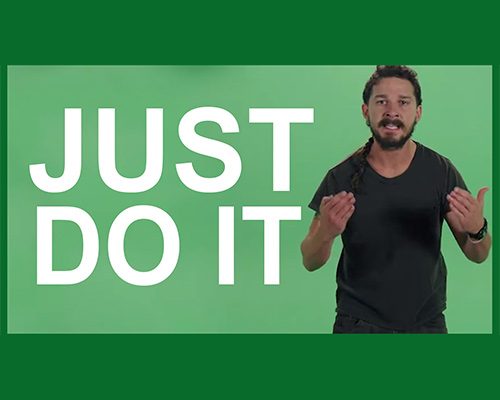As a PPC marketer, you know that before you can start optimizing your campaigns for conversions, you’ve got to get those clicks rolling in. Without enough volume, it’s impossible to have the confidence level you need to form a hypothesis to A/B test.
Job numero uno is to start optimizing your PPC ads for more clicks and start sending more traffic to your landing page (because you’re sending your PPC traffic to a landing page, not your homepage, right?)
Not to mention the fact that as your clickthrough rate (CTR) goes up, your cost-per-click will most likely start to decrease.
How do you get more clicks? Well, this is the $64,000 question that every PPC pro struggles with on a daily basis. Luckily, there are quite a few experts in our very challenging, data-driven business who have learned how to drive more traffic from PPC ads, and they have data and examples to prove it.
We’ve selected six of our favorites to share with you here from some of the best in the PPC biz. Read on to learn some simple tips that you can use to optimize your PPC traffic that will help you to see better results almost immediately.
1. Start generating urgency with countdown timers
Countdown timers can go a long way towards generating enough FOMO to get people to click on your ads. Johnathan Dane, founder and CEO over at KlientBoost, outlines how to do this in a post he wrote for the Unbounce blog.
And, as it turns out, adding a countdown timer is easier than microwaving leftovers. All you do is add this snippet, either in your headline or in your description:
{=
Once you’ve done that, you’ll see this popup, where you can choose your start and end date, as you see in the image below.
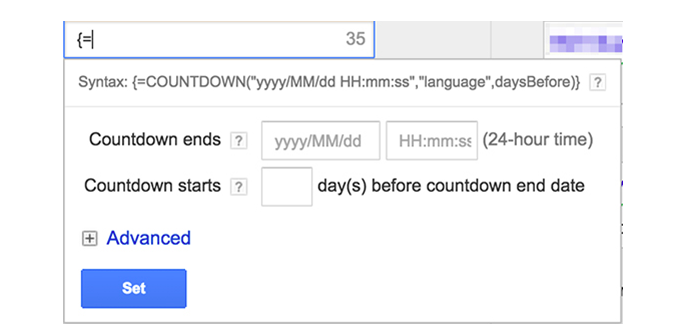
But Johnathan doesn’t want you to just take his word for it. He provides two examples in which this tactic worked very well.
In the first, an ad agency called Merkle | IMPAQT started using the countdown timers just before Black Friday. What they found was that ads with the countdown timer “performed at a significantly higher rate than other copy.”
And more than just increasing their CTR, they also found that conversions were higher on traffic from those ads, as well.
And over at Clarks America, they saw a 32% CTR jump with countdown timers.
It’s a very simple thing to implement and appears to have great effect under the right set of circumstances. Try it out for yourself and see how it goes.
2. Use ad extensions to increase visibility
Google likes it when you get a higher CTR. When someone clicks, they get paid. It’s in their best interests for you to get as high a CTR as you possibly can. So they do what they can to help you do that.
In the ebook, Creative That Clicks, Google recommends using ad extensions to increase your CTR. Here are the different types of ad extensions you can use, as defined by Google in that same ebook.
Review extensions recently became available and showcase positive third party reviews, rankings, and awards from reputable sources in your ads. Seeing a review from a credible source gives users valuable info that builds trust in your business. El Al, a leading airline in Israel, tested the extension last month and saw a 10% increase in CTR.
These are great stats. Let’s also take a look at some stats that don’t come from Google HQ.
Review extensions can increase clicks by up to 66%, according to research done by Hayley Coutinho, a PPC expert at Receptional Ltd. In a post for the Acquisio blog, Hayley shows us how it was done.
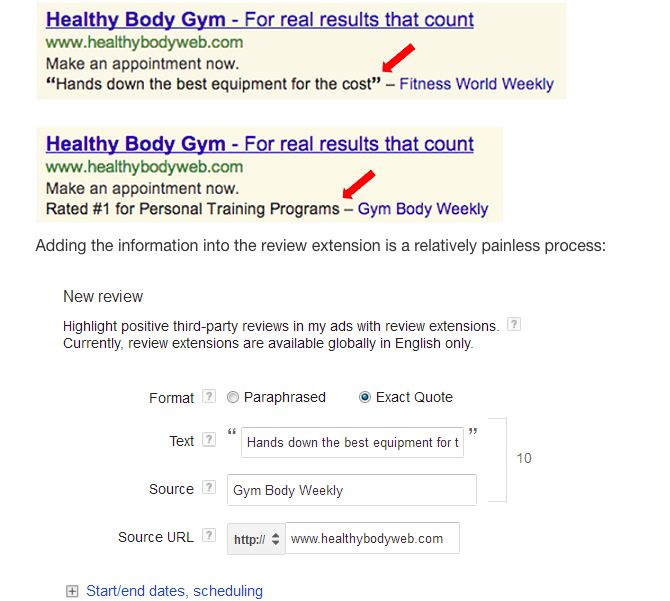
We put review extensions to the test over a 4-5 week period, during which time we collected some enlightening results. Initially, the ads running the review extensions were shown on about 10% of all ad impressions. In terms of CTR rates, the evidence was generally positive, with one review extension increasing CTR by 66%. The upward trend was also evident in terms of conversion rates.
Positive reviews mean a lot to people making decisions about products. Almost 90% of consumers claim that they’ll use online reviews to help them make decisions on which products to buy, so you’ll definitely want to make sure to use those reviews to your advantage and start getting more heavily qualified traffic to your pages.
3. Use symbols to get attention
Let’s take a look at a Google search for the term “iPad.” For this one, we’ll just look at the ads on the right-hand side, as opposed to those on top.
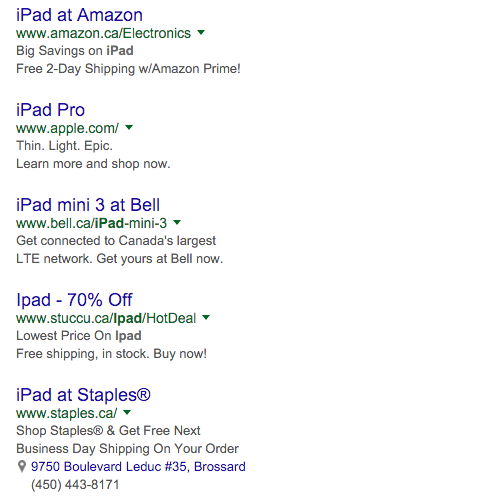
Out of the five ads that you see here, which one stands out most to you? I’m hoping you said numbers four or five, because those are the ones that I’m using to make the point that symbols help to get your ads to stand out from the competition.
Writing for The Huffington Post, Jonathan Long, founder and CEO of Market Domination Media stresses the importance of using symbols to draw attention to your ads.
Symbols really help an ad stand out (if they can be used correctly) when they are lined up against other similar ads selling the same product or service. In a sea of text, symbols really make an ad pop and stand out more.
You can see the difference they make in the example I used above. If you’re able to insert symbols in your ad copy that are relevant to what you do, give them a shot and see whether or not they increase your CTR.
After all, you can’t get a click if you don’t get noticed. And even if you’re the bottom ad, with a clever device like adding symbols, you can still be the ad that stands out the most.
4. Put the main keyword you’re bidding on in the URL of your ad
This one is about building the trust of the people who see your ads. Putting the main keyword in the URL of an ad gives readers one more clue that your ad is the most relevant to their search. When they see it, they can be more certain that your ad is providing them with what they’re looking for.
Here’s a great example of this in action from an article on the Wordstream blog written by Margot da Cunha from Wistia.
Margot shares two ads from a search she did in the image below. As you can see, one has used keyword placement in the URL, and the other has not. Guess which one she clicked on.
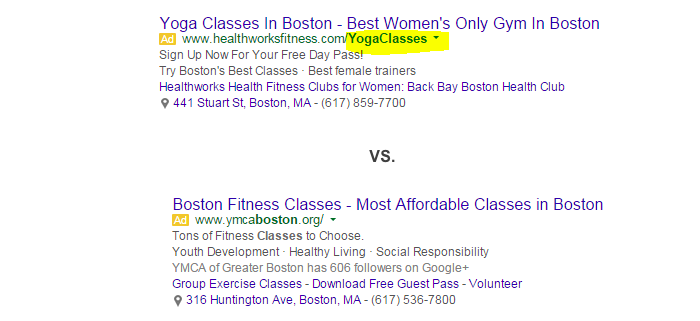
Amazingly, Wordstream’s research shows that out of 580,000 ads that they analyzed, a full 33% were not using keywords in their display URL. Margot goes on to say, “we consistently find that ads with keywords in their display URLs have much higher CTR than ads without.”
This is an incredibly simple thing that can be done in seconds to start generating more clicks. No excuses. Get to it.
5. Call your readers to action to get the click
I’m always amazed by what a kick-ass call to action (CTA) can do for an ad, and I was pleased to learn that the human mind actually expects a call to action from your PPC ad. Once someone views and clicks on an ad, they’ll be satisfying something deep down inside. And guess what, PPC marketer? You helped them do that!
Well, it’s not quite as dramatic as all that, but it is pretty awesome. Take a look at this:
One of the most powerful underlying forces in curiosity, however, is not satisfaction alone, but arousal. The idea of curiosity arousal occurs when a person can almost but not quite see, hear, or interpret something. For example, a child wants to see over a fence but is not quite tall enough. What do they do? They jump, climb, or cry. Their mind’s curiosity demands that their body satisfy it.
The above is from a post about the psychology of the CTA by conversion consultant Jeremy Smith. We can capitalize on our readers’ curiosity by giving them a reason to click, telling them that they should click with a well-placed CTA (like “find out more,” “get yours today,” or “download the ebook”).
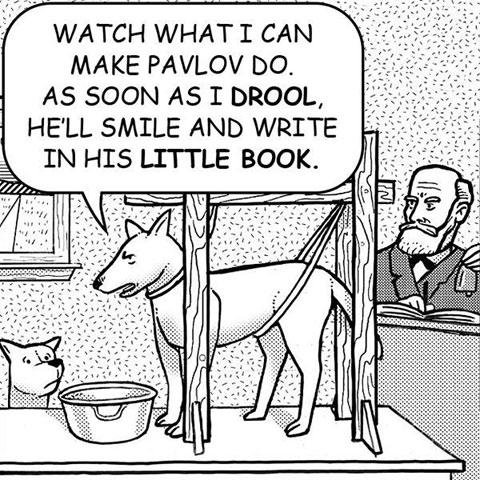
Google (remember how much they like clicks) suggests using a call to action in your ad copy to give your customers another reason to click. Here’s what they have to say in their Adwords Help section:
Are you selling something? Tell people what they can buy. Are you offering a service? Tell people how to contact you. Calls to action like purchase, call today, order, browse, sign up, or get a quote make clear what the next steps are.
That CTA can be the difference between your ad getting clicked or ignored. Make sure you’re helping those who see your ad to scratch that curious itch they feel when you’ve enticed them to click on your ad. You’ll get more clicks and they’ll breathe an inner sigh of relief.
6. Before writing a word of ad copy, get to know your audience
You want to boost the amount of traffic you generate, but at the same time you want to ensure that the traffic you’re getting is the right traffic.
To help you understand more about how to get to know your audience, let’s see what Peep Laja, founder of Conversion XL, has to say about how to identifying your online target audience. Here’s what Peep has to say about why knowing your audience matters so much:
If you know…
- who the people are, you know how to get to them (the blogs they read, the sites they visit, the stuff they search in Google etc)
- how they describe the type of services they offer, you can word the copy on your site to match the conversation in their head (very important!)
- how they choose and compare products in your category, you know how to structure and prioritize content on your site
- what they want, your value proposition can state exactly that and the whole site can be 98% relevant to them
- what they don’t care about, you can dismiss and cut it from the site
How do you find out who your audience is? Here are two of the methods that Peep recommends you use.
You can start by making assumptions
You may be working for or with a business that just doesn’t have any reliabledata that you can use to get to know your audience. In cases like this, Peep says, you’ll have to start with assumptions and educated guesses. He goes on to say that you’ll want to, at the very least, answer these three questions:
- Who are the target customers? Describe their life (or business) situation
- What do they want? What’s the pain?
- What are their needs that aren’t being met?
You will most likely find that, as you go along and start collecting data, some of your assumptions were wrong. The good part is that you had a place from which to get started.
Talk to your customers
A very valuable, and remarkably untapped source of information on what customers want is (drum roll, please) … your customers!
Peep says that once you’ve managed to put together a customer profile, you should get out into the world and start talking to them. If you can, track them down in their “natural habitat,” or, more precisely, their place of business.
Learn all you can from these conversations, and use that information to generate PPC ad copy that is really addressing the needs of your target audience.
Don’t forget to test!
These are simple tips that you can implement in almost no time at all. And if you do implement any of them, it’s really important that you test what you’ve done to make sure that your audience is responding in a positive way.
The most important thing is to make sure that you’re getting the traffic that’s right for you. Don’t just increase your traffic for the sake of more clicks — your goal is to increase your traffic to obtain more conversions.
So, keep testing at all stages of the path — from the ad to the landing page, and make sure you’re optimizing every single part of your marketing campaigns.
If you really want to make sure that you’re getting the most out of your PPC campaigns, download our PPC checklist to learn how to streamline your entire process and get the most out of your PPC campaigns.
